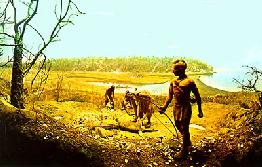|
Historical Background of Manhasset Bay
Early Settlement to the Early 1900s
Until the 1600s, the land around the Bay was inhabited by the Matinecock tribe of the Algonquin Indians who used the Bay for fishing and shellfishing. The tribe had a fishing village in what is now the "miracle mile" along Northern Boulevard. At the time, this area, which was known as Sint Sink, was traversed by an old trail that was used for travel from Queens to eastern Suffolk.

courtesy of the Garvies Point Museum
In the 1600s, the Dutch and then the English settled around the Bay and made fishing a major industry. The Bay was first called Schout's Bay by the Dutch settlers and then Howe's Bay by the English settlers. Because the early settlers farmed and grazed on the thousands of acres around the Bay, it later came to be called Cow Bay while the Port Washington peninsula was called Cow Neck. In the 1600s and 1700s, patents granted the Town of North Hempstead ownership and underwater rights in the portions of the Bay encompassing the area south of Barkers Point to Toms Point.
In 1895, the Long Island Rail Road began service to Manhasset and with this came an increase in growth and development in the surrounding area. Then in 1907, Manhasset was designated as the Town of North Hempstead seat and about this time the Bay's name was changed again, to Manhasset Bay.
By the early 1900s, the Bay had become known as the "shellfish garden of New York City" because of large areas with clam and oyster beds. However, while fishing and shellfishing continued as important economic activities, the growth and development around the Bay also resulted in a growing commercial and recreational boating industry.
The 1920s to 1940s
Beginning in the 1920s and up to the 1940s, there was a shift in the economic activities on the Bay from fishing and shellfishing to commercial and recreational boating. The commercial boating activity in the late 1920s was fairly substantial. For example, in 1927, over 700,000 tons of materials and supplies were moved into and out of the Bay. Of this, approximately 80 percent involved outgoing shipments of sand and gravel from Port Washington to New York City in support of massive construction projects there.
The other 20 percent of shipments involved incoming supplies delivered by barges mostly to the Manhasset/Great Neck area of the Bay in support of the growing population and associated development. These incoming supplies included brick, asphalt, lumber, coal, fuel and other construction materials needed to satisfy the rapid growth and development that was taking place along the north shore of Nassau County. These materials were off-loaded in Manhasset and Great Neck and trucked along Northern Boulevard. During this time, other important economic activities on the Bay included recreational boating and yachting at a number of marinas and yacht clubs, as well as the Navy testing PT boats and torpedoes in the Bay just prior to World War II.
Post World War II Development
Following the end of World War II to around 1970, there was even more growth on the two peninsulas, as well as most of the Town of North Hempstead and the rest of Nassau County. During this three‑decade period, the Town's population nearly tripled from 83,385 in 1940 to 235,007 in 1970 (LI Almanac, 1998). During this time boating activities increased with the increases in population, but the nature of the boating changed with less commercial and more recreational. This change was in large part due to shift in sand mining activities from Manhasset Bay to the Hempstead Harbor area. One important commercial use of the Bay that continued during this time, was the seaplane flights in and out of the Bay area. Little is known about swimming in the Bay during this time, but it is known that a number of beach clubs, and homeowner associations and yacht clubs provided bathing opportunities to their members. Therefore, this was obviously also an important activity on the Bay.
The 1970s to the Present
After population growth and development peaked around the Bay in the early 1970s, (it decreased 10% between 1970 and 1990) the Bay became one of the busiest embayments in the region with the Bay accounting for approximately 16 percent of all the marinas, boat yards and yacht clubs in the entire Long Island Sound region. Eventually, in 1994, due in large part to this extensive boating activity and associated economic importance, the State of New York designated Port Washington as a historic center of marine activity and Manorhaven as an area for concentrated development in its Coastal Management Program. In addition, the New York State Legislature approved the Historic Centers of Maritime Activity Act which designated Port Washington and 16 other communities on Long Island as a Historic Center of Maritime Activity.
|